Vegetable Stock Recipe (Stovetop & Instant Pot)
Vegetable Stock is a savory, aromatic, flavorful liquid made by gently cooking or simmering various vegetables, spices, herbs and seasonings in water, without using any animal products. My tried and true Vegetable Stock recipe is a real kitchen workhorse. Easily add tons of flavor to everything from soup to curry, gravy to risotto. As an added bonus, I have included directions for making my veg stock or vegetable broth on the stovetop and in the Instant Pot.
About Vegetable Stock Recipe
I have been making this delicious homemade vegetable broth for many years and I’m so happy to be sharing my recipe with you.
Laced with the perfume of fennel and coriander seeds, this vegetable broth infuses any recipe it touches with a delightful and distinctive seasoning.
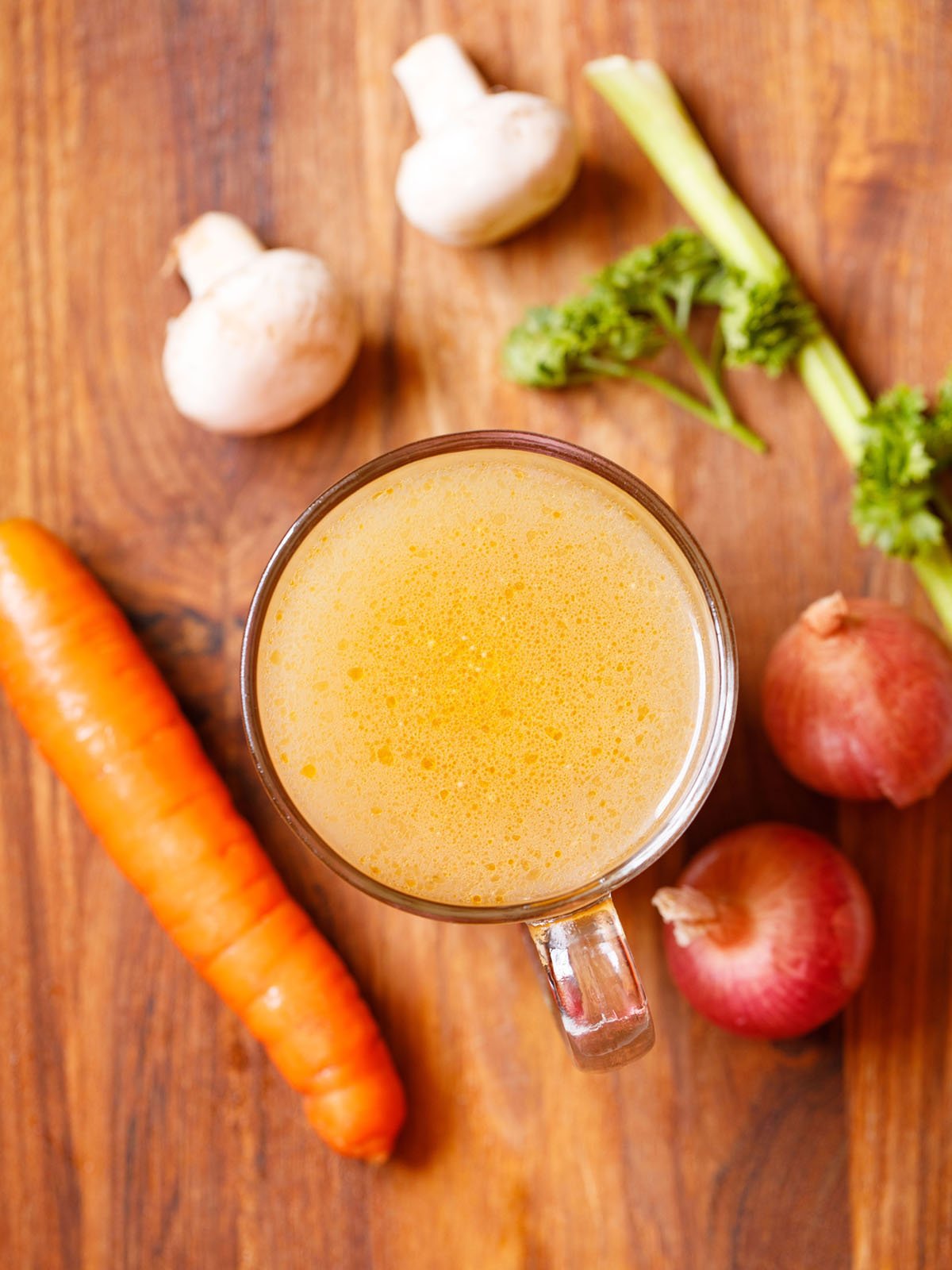
If you cook often like I do, I’m sure you’re aware of the power of stock. Much more appetizing than water, vegetable stock can be used in various recipes to add flavor and body.
Any savory recipe that calls for water can almost inevitably be improved upon by using stock in its place. In fact, next time you make a pot of rice, try using this vegetable broth instead of water. You won’t believe how much flavor it will lend!
I also love this recipe because it is so simple. With just a handful of ingredients, minimal prep time and a bit of patience, you can have a large batch of savory goodness ready.
My vegetable stock recipe is also very concentrated, meaning you don’t need to use a lot to give a lot of flavor and can dilute it with some water.
I like to make a big batch of this veggie broth and freeze it in ice cube trays. The stock cubes are extremely handy to use in any recipe.
I use it for soups, curries, pulao, risotto and gravy. I also love heating up a mug full to sip on whenever I’m feeling under the weather.
The essential ingredients for this recipe are very easy to find – onion, celery, carrots and garlic. From there, you can easily customize this vegetable broth to fit your needs by using the herbs of your choice.
Is Vegetable Stock the Same As Vegetable Broth?
Indeed it is! Stock and broth are often used interchangeably. While I learned the term “vegetable broth” when I was in cooking school, nowadays people seem to call it “vegetable stock” just as often.
Technically speaking, stocks are made with meat and broths are made with vegetables. But since the rest of the world doesn’t seem to mind, neither will I! Use this delectable liquid in any recipe that calls for either stock or broth.
Vegetables to Include
The basic version of just about any vegetable broth starts with the French trinity of onions, celery and carrots. These are non-negotiable and essential in a vegetable stock recipe.
However, you can easily switch things up by adding some other veggies to the mix like:
- Tomatoes: increases the acidity and give the stock a beautiful hue.
- Corn cobs – imparts a delicious sweetness.
- Fennel bulb – gives a lovely licorice like flavor.
- Leeks – for a mild onion-like aroma.
- Parsnips – imparts an earthier, sweet and nutty flavor.
- Mushrooms like button, shiitake or cremini – will give a lovely umami flavor.
Tip: If you cook often, I recommend keeping a gallon sized freezer bag for your veggie scraps. The skin and root ends from garlic, onions, celery, carrots, the stems from your herbs can all get tossed in. When the bag is full, you can use it to flavor your stock!
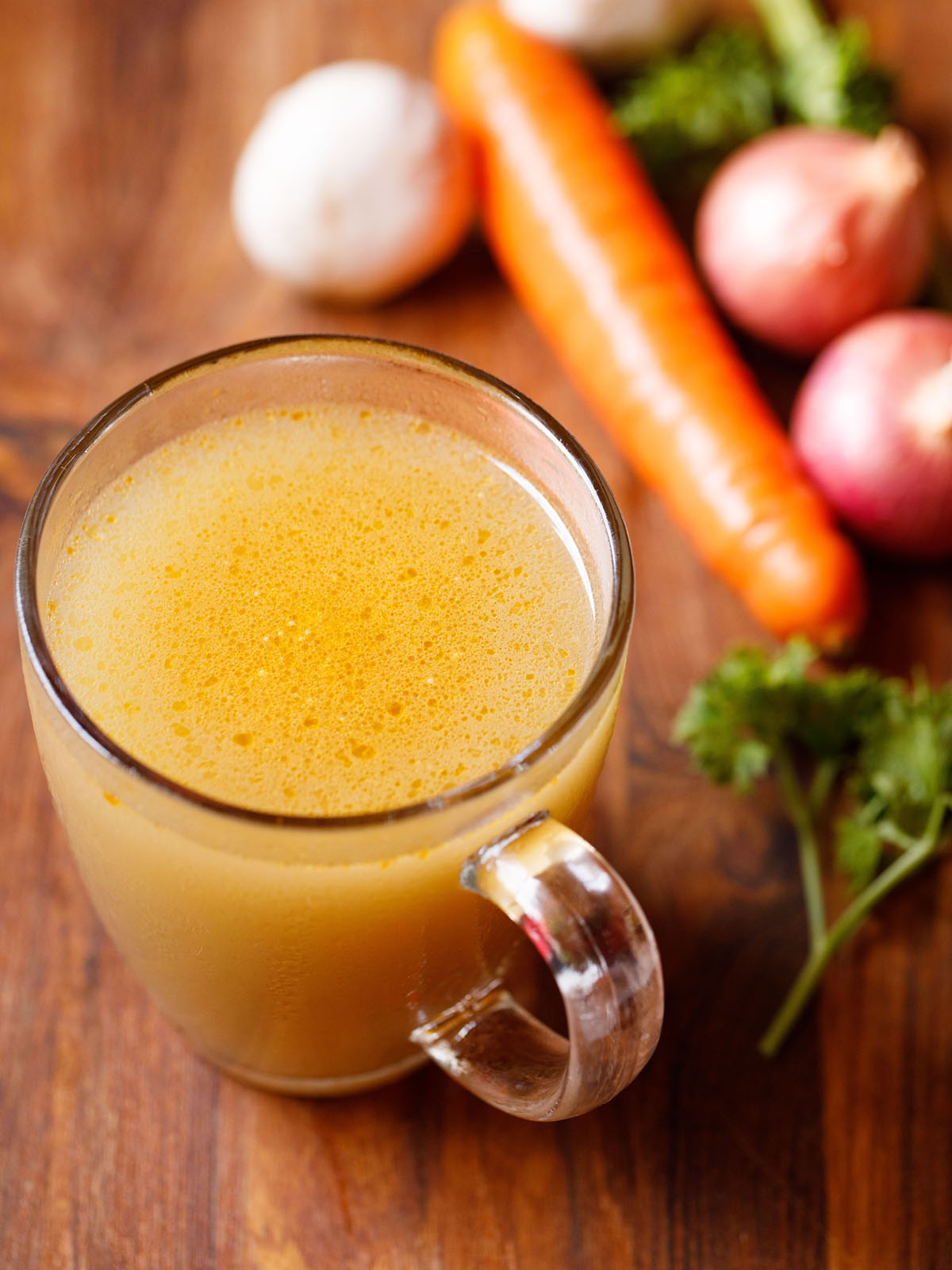
Vegetables to Avoid
There are some vegetables that you have to avoid adding in your vegetable broth recipe. They can make your stock bitter, cloudy or slimy.
1. Watery Vegetables
I do not suggest to add some watery vegetables like gourds to the stock as they do not offer a whole lot of flavor and can make your stock cloudy or dark.
- zucchini
- summer squash
- okra
- cucumber
- eggplant
- radishes
- beets
2. Cruciferous Vegetables
I also recommend steering clear of any cruciferous veggies in a vegetable broth recipe as they lend an almost sulfurous flavor to the batch.
- cauliflower
- broccoli
- cabbage
- brussels sprouts
3. Starchy vegetables
I also suggest avoiding starchy vegetables as they will make your broth quite cloudy, thick and starchy.
- potatoes
- sweet potatoes
- peas
How to Make Vegetable Stock
Preparation
You will need the following proportions of the veggies and herbs:
- 1 to 1.25 cups chopped onions
- 1 cup chopped carrots
- 1 to 1.25 cups chopped button mushrooms
- ⅓ cup chopped tomatoes
- ⅓ cup chopped celery or 2 celery stems (with or without leaves)
- ⅓ cup chopped parsley (both leaves and stems)
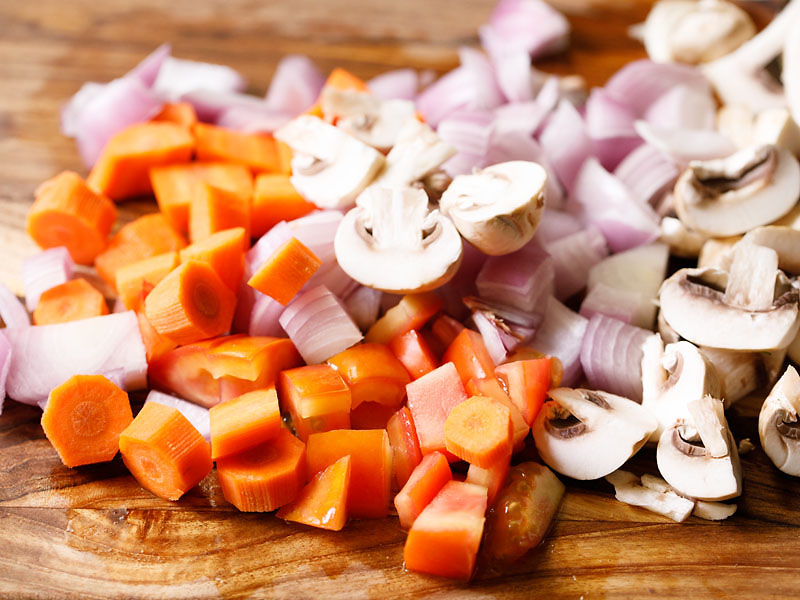
Cooking Stock on the Stovetop
2. Heat oil in a large pot or sauce pan. Add lightly crushed 4 medium-sized rinsed garlic cloves (with their peels) and 1 small to medium bay leaf or tej patta.
Sauté for a couple of seconds. Do not brown the garlic. Sautéing the garlic and bay leaf will extract maximum flavor.
Tip: In the stove-top method I have added oil, but this can be skipped if you prefer.
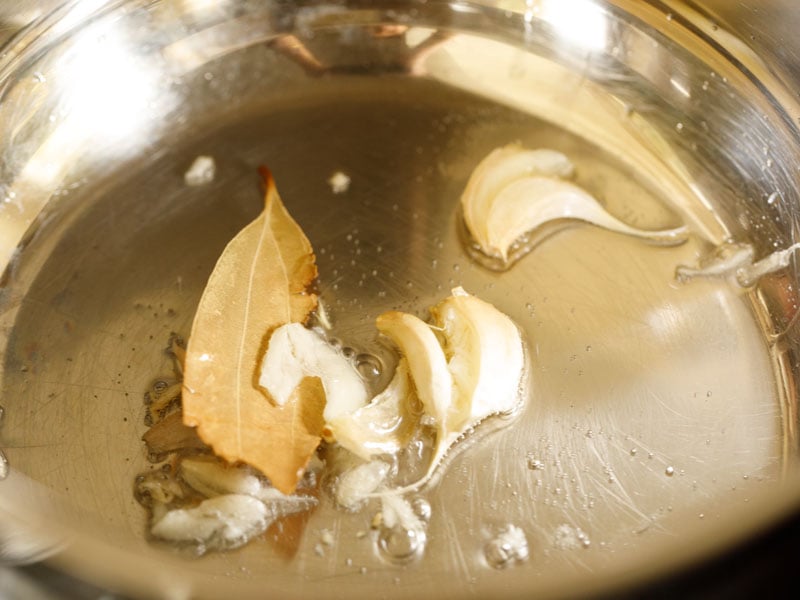
3. Add chopped mushrooms, onions, tomatoes and carrots.
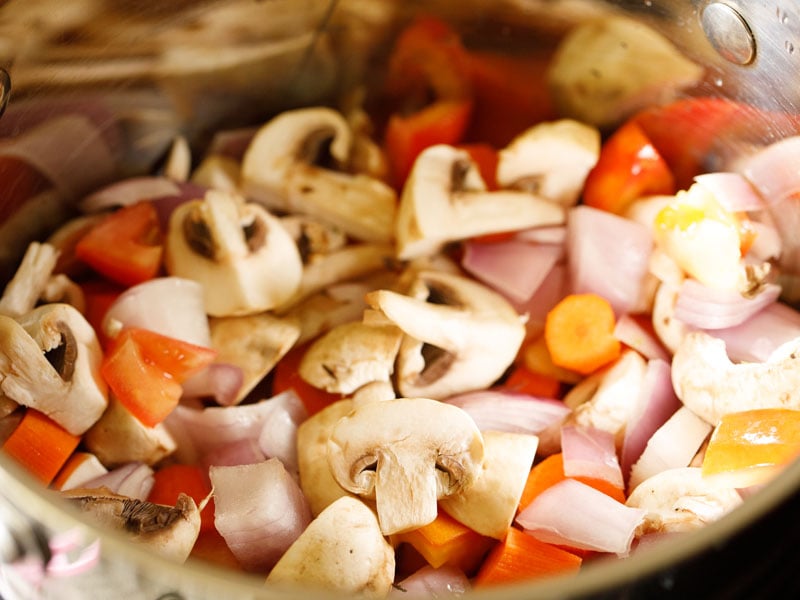
4. Mix and sauté them for a minute.
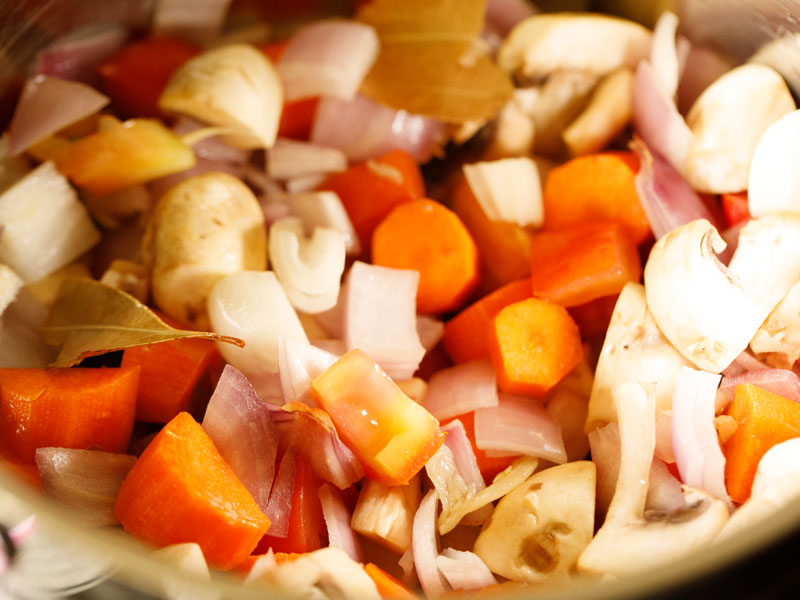
5. Add the chopped parsley and celery. Quick note: celery leaves are often discarded, but you don’t have to remove them for this recipe!
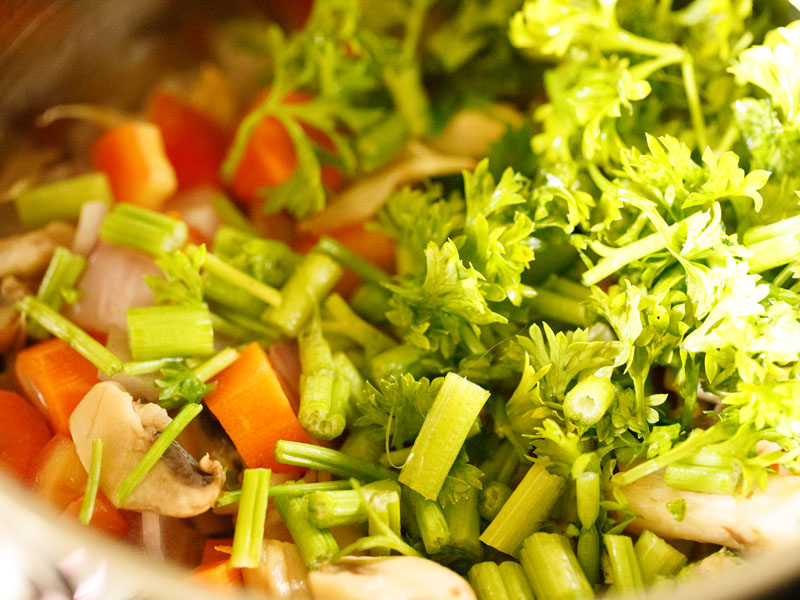
6. Add the spices:
- 1 tablespoon coriander seeds
- 2 teaspoons fennel seeds
- 3 cloves
- ½ teaspoon black peppercorns
- 1 to 1.5 inches true cinnamon (Ceylon cinnamon)
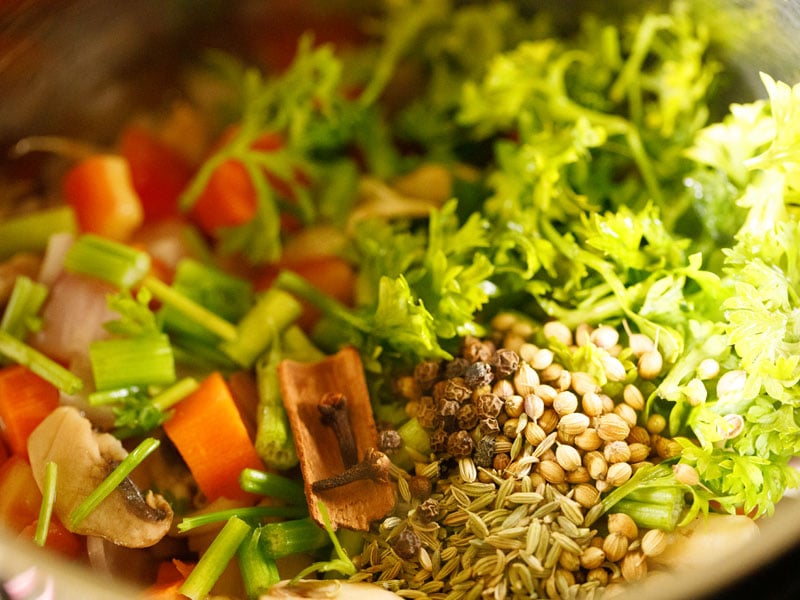
7. Add 4 cups water. Mix and stir well.
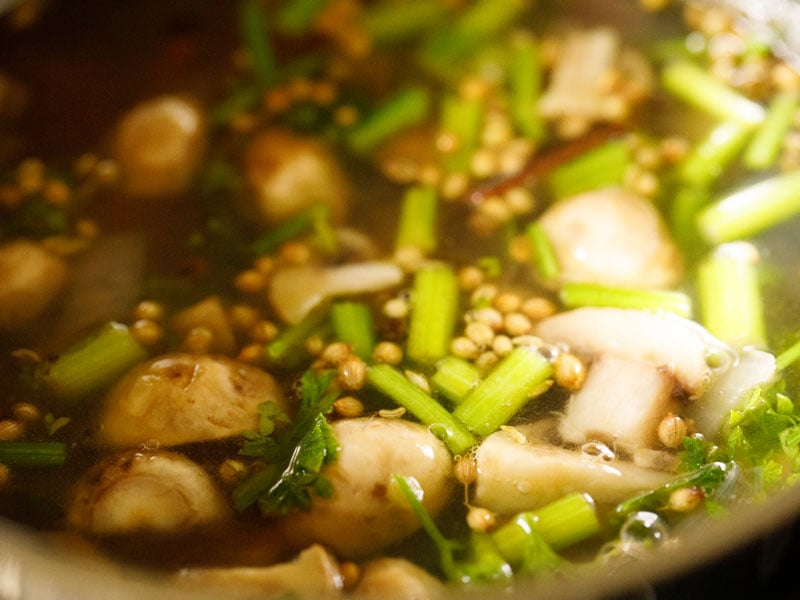
8. Cover and simmer for 30 to 45 minutes on low to low-medium heat.
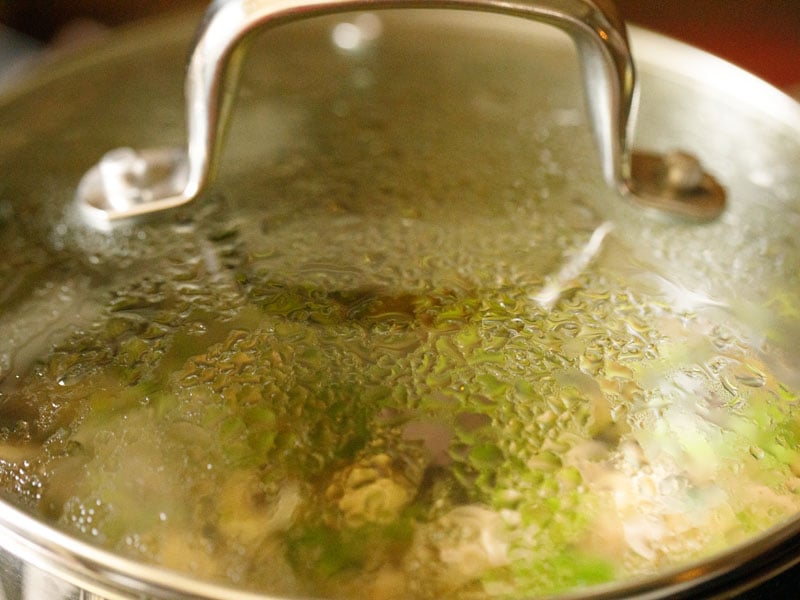
Cooking in the Instant Pot
9. The Instant Pot version of my stock has all the same ingredients and quantities as the stovetop version with the notable exception of oil and more water.
Add 6 cups of water rather than 4 if you are making this in the Instant Pot.
Place the chopped veggies, herbs and spices in the steel insert of a 6 quart Instant Pot.
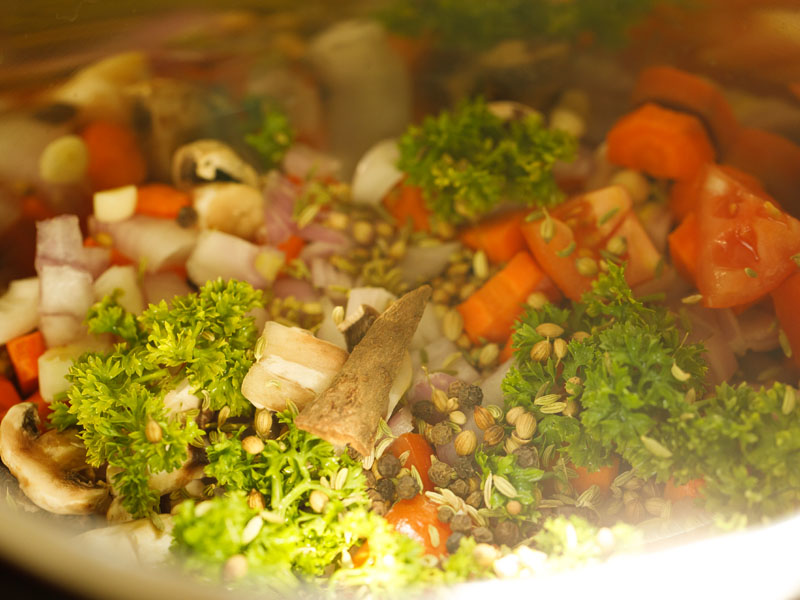
10. Add water and give a nice stir.
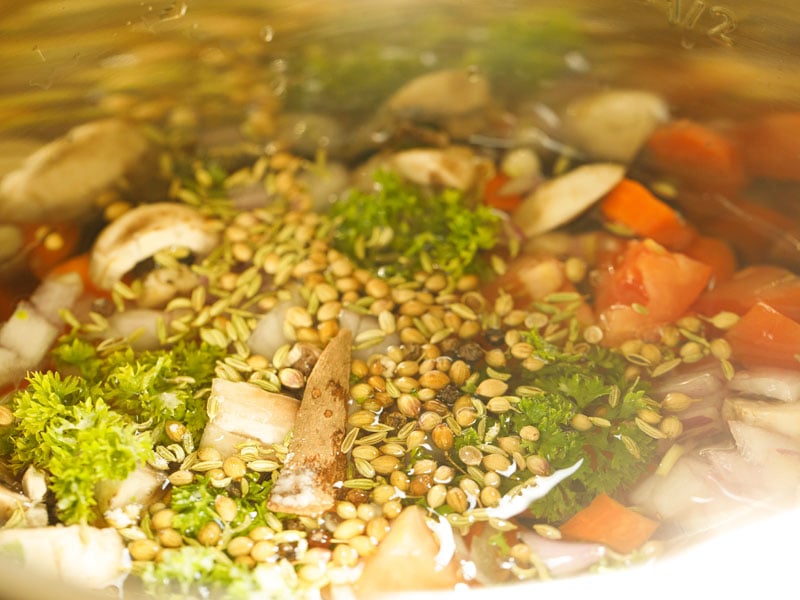
11. Secure and lock the lid firmly on the Instant Pot. Turn the steam release valve to the ‘sealing position’ to build pressure in the Instant Pot.
Pressure cook on high pressure for 15 minutes. Let pressure release naturally. Cool at room temperature.
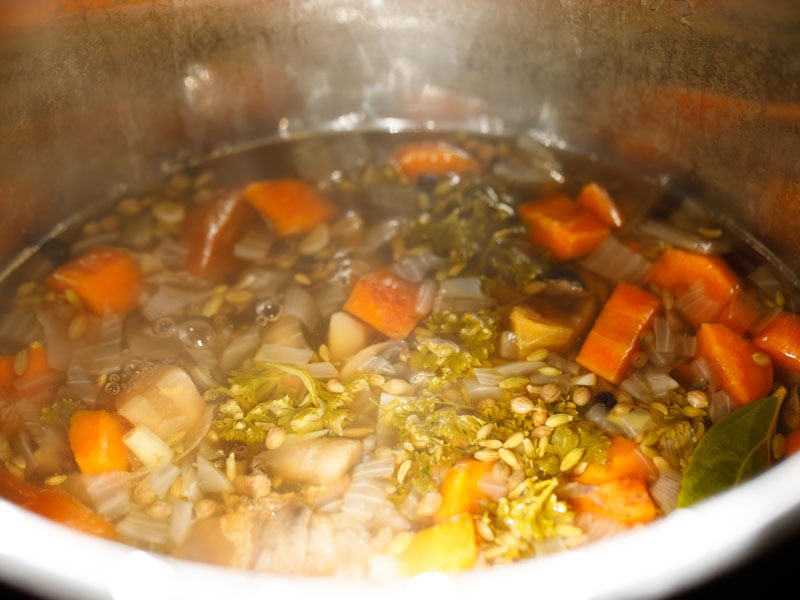
Straining Stock Liquid
12. Regardless of whether you opted for the stovetop or Instant Pot method, you will need to strain your stock.
Below is what it will look like after cooking. Let your stock completely at room temperature, before you strain it
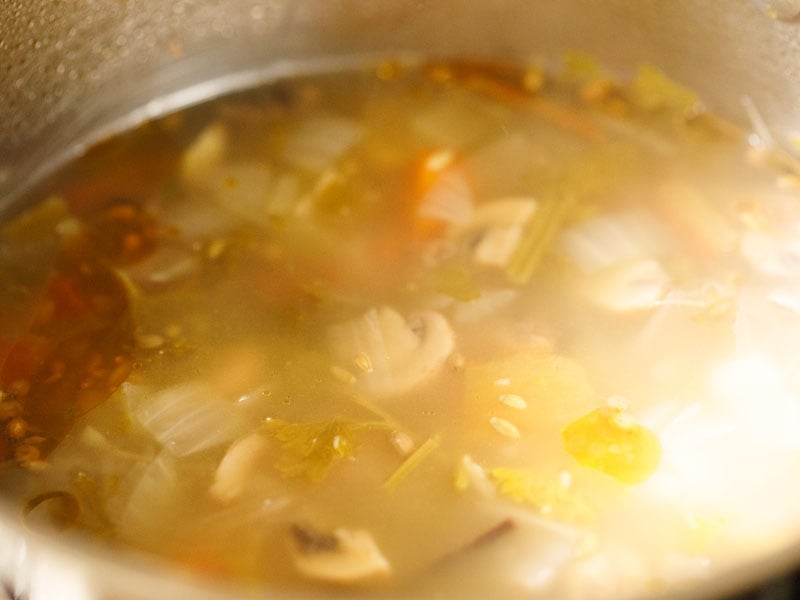
13. Let it cool and then pass through a strainer. Mash the veggies lightly if you prefer.
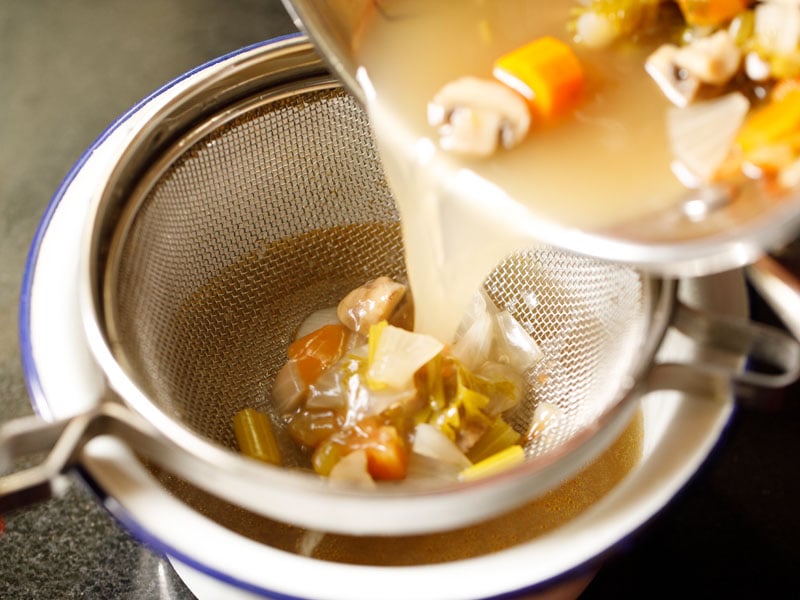
14. Here is the flavorful homemade vegetable stock after straining.
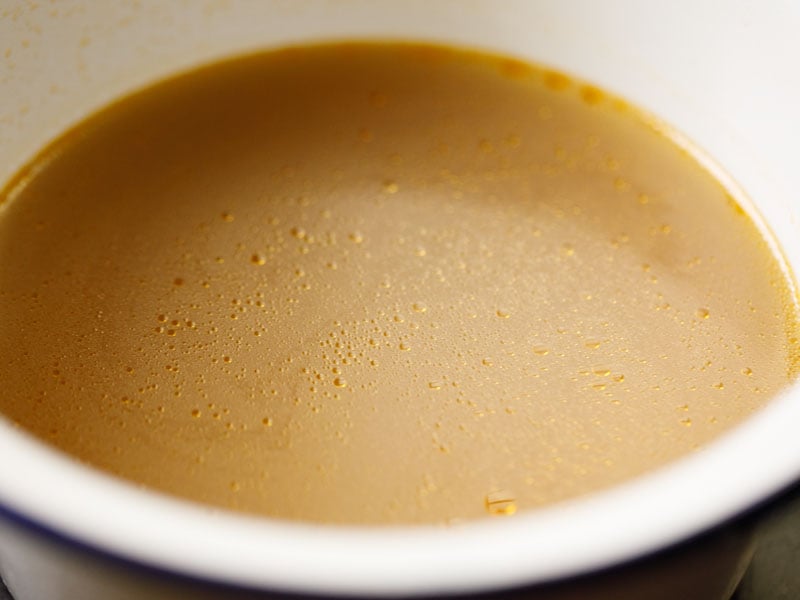
15. I love to pour the stock into ice cube trays and pop them in the freezer.
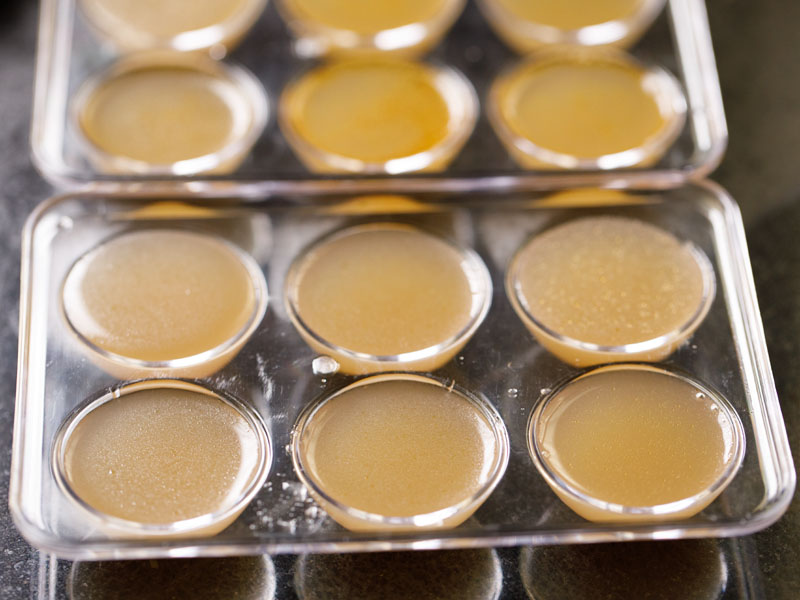
Once they are frozen, I keep them in a zip lock bag so I can easily add stock to anything I’m making.
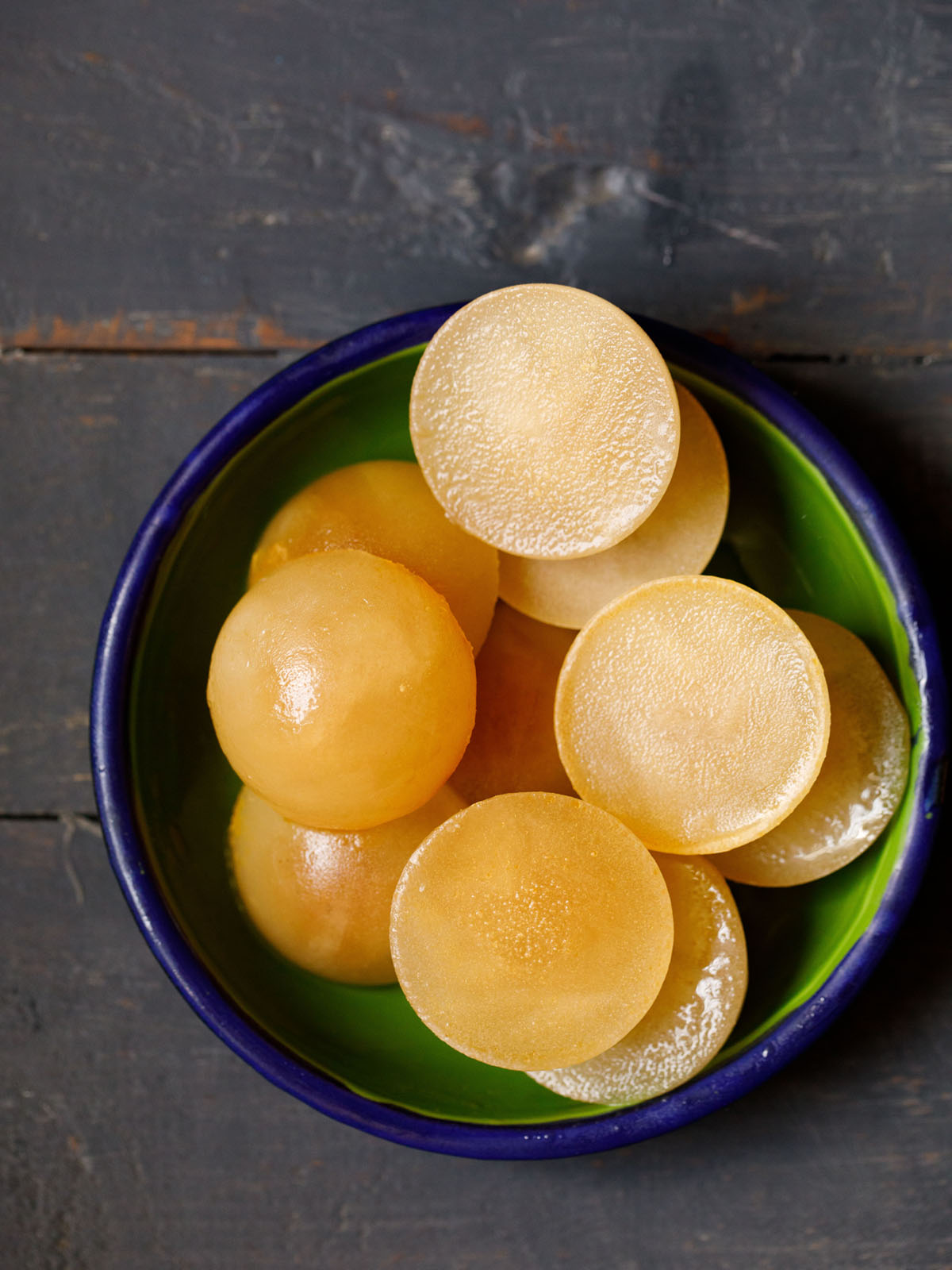
How to use Vegetable Broth
This delicious and flavorful broth can be used in myriad ways. Use it to make your favorite soups, stews, curries, gravies and more! Literally any recipe that calls for vegetable broth/stock (or even chicken broth/stock!) will benefit from your homemade stock.
Here are a few of my favorite recipes that call for veggie stock:
How to store Veg Stock
This homemade vegetable stock will keep in a lidded container in the refrigerator for up to a week. You can also do what I do and freeze some in ice cube trays. Once they are frozen solid, pop them into a bag for easy access.
Finally, if you want to store your homemade vegetable broth in the freezer, but would rather not freeze it into cubes, you can use freezer bags instead.
How to get the most flavor from your Vegetable Broth
The trick to any broth or stock recipe is slow simmering. The low heat coaxes all the flavor from the vegetables over time. For this recipe, you can simmer for up to 45 minutes.
Take care not to boil the stock, as this will end up in veggies that are decimated. It will make it near impossible to strain all of the solids from your final product.
Finally, make sure to allow the stock to cool completely before straining. This will help to pull out any remaining flavor from the vegetables and will help to ensure that they stay intact when you strain.
How to customize the flavor of this veggie stock?
I recommend that no matter how you flavor your broth, make sure you keep the celery, carrots and onions.
While you can skip adding fennel seeds and coriander seeds, both give a lovely flavour. The coriander and fennel is a secret I learned from my Mom. She adds these seeds to her stock that she uses for Yakhni Pulao, and it is honestly the best I’ve ever had.
If you love the flavor of coriander (cilantro), feel free to substitute fresh coriander leaves for the parsley. In fact, including different herbs and spices is a great way to customize your flavor profile.
You can also add things to your stock to change the flavor. Tomatoes will add some acidity, mushrooms or nutritional yeast will add umami, and corn cobs will add sweetness.
Adding dried shiitake mushrooms
Rinse about 6 to 7 dried shiitake mushrooms thoroughly in fresh water. Soak for one to two hours in 2 cups of warm water.
When they soften, add them with the soaked water to the remaining vegetables. Additionally add 2 cups water of water if making veggie stock on the stovetop or 4 cups of water for Instant pot cooking.
Expert Tips
- Vegetables to include: Onions, carrots, tomatoes, fennel bulb, corn cobs, leeks, parsnips and edible fungi like button, shiitake and cremini mushrooms are perfect for a veg stock.
- Vegetables to avoid: Zucchini, summer squash, eggplant, okra, radishes, beetroot, cauliflower, broccoli, cabbage, brussels sprouts, potatoes, sweet potatoes and green peas need to be avoided in a veg stock.
- Dried shiitake mushrooms: if using shiitake mushrooms, rinse about 6 to 7 of them thoroughly in fresh water. Soak for 1 to 2 hours in 2 cups warm water. When soft, add them with the soaked water to the remaining vegetables. Additionally, add 2 cups water for stovetop cooking or 4 cups water for Instant Pot cooking.
- Spices and herbs: For a beautiful flavor in the veg stock, you can add fennel seeds or coriander. These can be skipped too, but make sure to add the celery. Other than these, you can make a customized stock with your choice of herbs and spices. For an umami twist, you can add some nutritional yeast as well.
- Cloudy stock: If you have made Vegetable Stock with vegetables you had and got a cloudy stock, then do not worry. Simply strain it twice using a fine strainer, placing a cheesecloth or muslin on a strainer.
- Storage: You can refrigerate the stock in a container fitted with a lid for about 7 days. To freeze the stock, you can pour it in ice cube strays and once frozen, add in a bag for easy access. Or you can use freezer bags instead.
FAQs
This stock is a little potent for my taste. Any suggestions?
I like my stock to be quite concentrated for the most oomph. That said, you can easily add more water to dilute it to your preference.
Can I re-use the vegetables after I strain the stock?
After making the stock, the vegetables will have given up most of their flavor and will become soft and mushy. I don’t recommend using them in any recipes, but they will do wonders for your compost!
Can I use a slow cooker or crockpot to make this homemade veggie broth?
Absolutely! Simply add your vegetables, herbs, spices and 6 cups water to the crockpot and let it simmer on low for 8 to 9 hours.
Step by Step Photo Guide Above
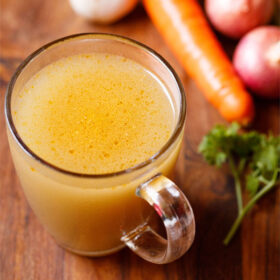
Vegetable Stock Recipe (Stovetop & Instant Pot)
Ingredients
- 1 tablespoon oil – any neutral oil, optional
- 1 bay leaf (small to medium sized) or tej patta
- 4 garlic cloves (medium-sized) lightly crushed with peels
- 1 cup chopped carrots or 2 medium-sized carrots
- 1 to 1.25 cups chopped onions or 1 medium to large onion
- 1 to 1.25 cups chopped button mushrooms or 8 to 10 button mushrooms
- ⅓ cup chopped tomatoes or 1 small to medium sized tomato
- ⅓ cup chopped celery or 2 celery stems, with or without leaves
- ⅓ cup chopped parsley – both leaves and stems
- 3 cloves
- 1 to 1.5 inches cinnamon – true cinnamon and not cassia cinnamon
- 2 teaspoons fennel seeds
- 1 tablespoon coriander seeds
- ½ teaspoon black peppercorns
- 4 cups water or add as required
Instructions
Preparation
- Rinse and roughly chop or slice carrots, tomatoes, onions and button mushrooms. Chop your herbs.
Cooking stock in a pot
- Heat oil in a large pot or sauce pan. Add lightly crushed garlic cloves and bay leaf or tej patta.
- Add the chopped veggies and mushrooms. Sauté for a minute.
- Add the chopped herbs and whole spices – parsley, celery, coriander seeds, fennel seeds, cloves, black peppercorns and cinnamon.
- Add water. You can add more water to get a slightly diluted light stock.
- Cover and simmer for 30 to 45 minutes on low heat to medium-low heat.
Straining
- Let the vegetable stock cool completely at room temperature. Then filter it through a strainer.
- Mash the veggies lightly if you prefer.
- I pour them in ice cube trays, so that I can pop in the frozen veggie stock when making any recipe.
Instant pot vegetable stock
- Except for oil, add the chopped veggies, mushrooms, herbs and spices in the steel insert of a 6 quart IP.
- Add 6 cups water and mix.
- Secure and lock the lid firmly on the Instant Pot. Turn the steam release valve to the 'sealing position' to build pressure in the Instant Pot.
- Pressure cook on high pressure for 15 minutes. Let pressure release naturally.
- Cool the vegetable broth and then strain and store.
Storing Suggestions
- Store this homemade vegetable stock in a lidded container in the refrigerator for up to a week. You can also do what I do and freeze some in ice cube trays. Once they are frozen solid, pop them into a zip-lock bag for easy access.
- If you want to store your homemade vegetable broth in the freezer, but would rather not freeze it into cubes, you can use freezer bags instead.
Uses
- This flavorful broth can be used in so many ways. Use it to make your favorite soups, stews, curries, gravies and more! You can use it any recipe that calls for vegetable broth/stock (or even chicken broth/stock!).
Notes
- Use vegetables like onions, carrots, tomatoes, fennel bulb, corn cobs, leeks, parsnips and edible fungi like button, shiitake and cremini mushrooms.
- Avoid veggies like zucchini, summer squash, eggplant, okra, radishes, beetroot, cauliflower, broccoli, cabbage, brussels sprouts, potatoes, sweet potatoes and green peas.
- Feel free to customize this vegetable stock recipe with your choice of spices and herbs. You can skip adding the fennel seeds and coriander, but do not skip on the celery.
Nutrition
Vegetable Stock recipe from the archives was first published on January 2021.


Hi, The recipe sounds great. What size instant pot is this for? I have the 3 litre one, the smallest one. Thanks
I have used 6 quart size.
Hello Ma’am
I really like your all recipes. I appreciate you. All the very best. Your presentation and your way to cook is really amazing. Well done Ma’am ?
Regards???
Thanks so much Poonam. Happy to read your comment. Thanks for the rating too on this recipe.